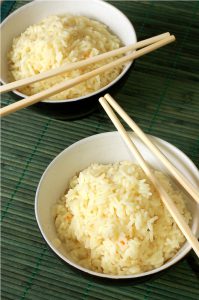Wise up to rice!
White rice is an integral part of any Asian diet and it would be very hard to avoid it. However, is white rice healthy and are there better options?
BY: Tan Boon Leng
 Rice is a staple food in our Asian culture, and come lunch or dinner, it is not uncommon to find a bowl of steaming white rice in the company of an assortment of cooked dishes. But is white rice good for seniors’ health? We give you the lowdown:
Rice is a staple food in our Asian culture, and come lunch or dinner, it is not uncommon to find a bowl of steaming white rice in the company of an assortment of cooked dishes. But is white rice good for seniors’ health? We give you the lowdown:
1) Packed with nutrients
White rice belongs to a group that nutritionists call “refined grain foods”. This group includes vermicelli (bee hoon) and fat glass noodles (kway teow). Refined grain foods are processed to give them their creamy white colour as well as their soft texture. However, in the processing, nutrient-dense parts of the grain are removed. Grains that do not have these parts removed are known as “wholegrain foods” and they include brown rice, red cargo rice, wild rice, wholemeal bread and whole wheat pasta.
Compared to white rice, brown rice and other wholegrains are healthier choices as they contain more fibre (soluble and insoluble), vitamins (B and E), minerals (iron, magnesium, zinc and selenium), and phytochemicals (beneficial plant substances such as lignin, inulin and phytic acid).
2) Driving up your blood sugar … and weight
Do you still feel hungry after wolfing down a big bowl of white rice? Don’t worry, this does not mean you are a glutton. White rice is easily digested, causing the body’s blood sugar levels to rise rapidly and then fall rapidly. This causes you to feel hungry easily.
In contrast, wholegrain foods release sugars more slowly into the body, and the rise and fall of the blood sugar is thus more regulated. This helps in weight management because when you feel fuller, the tendency to snack is reduced.
For people who have diabetes or have been diagnosed as pre-diabetic, white rice and other refined grain foods like white bread and sugar are not so salutary to the body’s ability in monitoring blood sugar levels. Therefore, eating brown rice and other wholegrain foods is a better choice and will allow diabetics to better control their blood sugar levels.
3) Much needed fibre
Brown rice packs a punch with its high fibre content. One bowl of cooked brown rice has three times the fibre content of an equivalent bowl of cooked white rice. Fibre is essential for promoting good intestinal functions, controlling blood sugar and preventing constipation.
However, for a very small group of people who can’t handle too much fibre, which may cause them to suffer from stomach discomfort such as bloating or gas, a tip is to space out your servings of brown rice and other fibrous foods over a few meals (e.g. lunch and dinner, rather than having everything in one meal). However, this does not mean you should boot out brown rice completely.
If you have been eating your daily recommended servings of vegetables and fruit (this means two servings of fruit, two servings of vegetables and two to three servings of meat, fish, dairy or bean products), you may want to incorporate brown rice into your diet as a good alternative to white rice.
4) More variety is better
The fragrant aroma of that steaming bowl of white rice tickling your nostrils and bringing on the hunger pangs can be hard to resist. However, before you decide to brand white rice and all other refined grain foods like white bread and noodles as ‘evil’ and eliminate them completely from your diet, think again. Remember the saying –“variety is the spice of life”.
Though it may be hard to get use to eating brown rice because of its chewy texture, it can certainly give you another variety to eat! Nobody enjoys eating the same old thing day in and day out. Other white rice alternatives that you could consider would be couscous (this pasta is a low-fat complex carbohydrate) and quinoa (is said to contain higher protein and iron content than most grains). Eating the recommended servings of wholegrain foods as part of a healthy diet will lower your risk of heart disease and diabetes.
So how much should one take? Those over the age of 51 and above are recommended to eat four to six servings of rice and alternative foods daily. More active people should consume up to six servings, whereas those leading a more sedentary lifestyle should eat about four servings. Of these, it is recommended that two to three servings should comprise wholegrain foods.
An example of one serving of rice and alternatives:
|
REFINED GRAIN FOODS: |
EQUIVALENT WHOLEGRAIN FOODS: |
|
½ bowl of white rice |
½ bowl of brown rice |
|
2 slices of white bread |
2 slices of wholemeal bread |
|
1½ cups regular cereal |
1 bowl cooked oats |
|
½ bowl of noodles/pasta |
½ bowl of brown rice bee hoon/wholewheat pasta |
It is never too late to start making gradual changes to your palate and diet if you want to continue to be in the pink of health!
** Special thanks to: Benjamin Lee, Nutritionist, Adult Health Division, Health Promotion Board, for his help with this story.
(PHOTO CREDIT: TWO BOWLS OF HEALTHY ORGANIC RICE © Suto Norbert | Dreamstime.com)

0 Comments